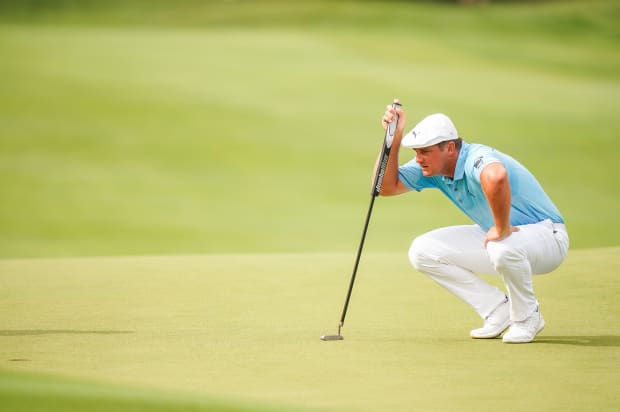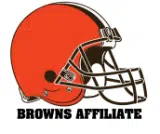Sure, U.S. Open champ Bryson DeChambeau, the hottest player in the world, wants to win more majors. But chasing titles is secondary to something even more elusive—the perfect, repeatable swing—which he pursues by examining, questioning, reimagining and obsessing over every aspect of the game.
Golf’s brainiest player would like you to know he is no genius. Bryson DeChambeau took a four-hour IQ test not long ago, for a company he works with called Neuropeak, and he scored 121—above average, certainly, but not Mensa material. Sure, the man they call the Scientist talks excitedly about air density and wind vectors, spreads the gospel of single-length irons, and once said he would decide whether to pull the pin on putts based on the coefficient restitution of the flagstick. But that’s passion, not genius. Despite how he acts sometimes, DeChambeau does not always think he is the smartest person in the room.
His IQ is a nugget of information, and DeChambeau shares it because he is obsessed with information. Pursuing it, understanding it and using it is the core of his success. Tiger Woods is famously trying to surpass Jack Nicklaus’s 18 major championships, Rory McIlroy is focused on winning the Masters to complete a career Grand Slam and Brooks Koepka is aiming to win at least 10 majors. The 27-year-old DeChambeau has every reason to set high goals, too. He is just the third player, after Nicklaus and Woods, to win the U.S. Amateur, the NCAA championship and the U.S. Open. He has been the PGA Tour’s best player since the June restart, and he crushed the Open field in September at Winged Foot by six strokes.

DeChambeau, who tied for 29th at Augusta National last year, will be the favorite when the 2020 Masters tees off on Nov. 12. But the world’s No. 5 player says he is not gunning for a certain total of titles. To DeChambeau, golf is not a game to be played but a puzzle to be solved.
***
Golf’s most famous numbers-cruncher does not write down his score after every hole. He waits until he has finished the front or back nine, then enters all his scores—and all of his playing partners’, too. This is odd for many reasons, but one is that by DeChambeau’s own admission (confirmed by testing), his short-term memory is not great. “As a kid, when I would study for tests, it always took me double the amount of time for somebody else to study,” he says. “I couldn’t remember stuff. I would read it, read it, read it and it just would not happen.” He struggles to recall numbers, but he intensely soaks in experiences. He can wait to write down 27 golf scores at once—nine for him, 18 for his two playing partners—because he remembers every shot they hit.

DeChambeau does not just love seeking information; he processes it with extraordinary efficiency. He used to routinely solve a Rubik’s Cube in less than a minute.
“There’s one area that I’m at the top of the line—I mean, [top] 0.01%,” he says. “[Neuropeak] couldn’t believe that I could do this. But spatial reasoning was off the charts. So my ability to look at a situation and problem-solve the situation is just—it’s quicker than anybody they’ve ever recorded.”
***
Golf’s hottest player rarely plays a round of golf. DeChambeau’s home club is Dallas National (he has remained in the city after getting a physics degree from SMU in 2016), a Tom Fazio design that Golf Digest ranked No. 65 on its list of the U.S.’s 100 best courses. But DeChambeau says he plays it “maybe once” a year. In the spring, while the Tour was shut down because of the coronavirus pandemic, he used the course’s practice facility for three or four hours every day but never went out for a round.
The putting green at Dallas National is fewer than 100 steps from the driving range; if the walk between them were dotted with landmines, DeChambeau would never have been in danger. He never once thought, “I’m going to practice my putting now.” And so he didn’t. He says he doesn’t need to practice putting because “the past two, three years, we’ve learned everything that I needed to learn in order to launch the ball properly control speed and start it on my line. That’s all it is.”
When DeChambeau was an 11-year-old, his coach, Mike Schy, asked him to do a drill to teach squaring the club face: Hit a car tire in a bunker with a 7-iron, and don’t speak. The tire moved, at most, a quarter inch every time Bryson connected. He did it for six hours and never said a word. In physics class at Clovis (Calif.) East High he filled a two-inch, double-sided notebook with notes. “I get times where I have massive spurts of OCD,” he says. “I can get very addicted to things pretty quickly.”

When DeChambeau played volleyball he got frustrated by teammates who did not take it as seriously as he did. This was not just the hyper-competitiveness or ego of an elite athlete. There was a puzzle there to be solved and, like kids thoughtlessly fumbling with a Rubik’s Cube, they didn’t try hard enough to solve it. “I didn’t like being around people because I couldn’t relate to anybody,” he says. “I liked being more of a nomad. I like being by myself, because I can figure stuff out quicker.”
Figuring stuff out is his favorite sport. Most golfers practice so they can play well. DeChambeau prefers the laboratory of the driving range to the canvas of the course. In Schy, DeChambeau found a coach willing to indulge all his dorky fantasies. “I’m just as crazy as him,” Schy says. “He knew that.” The single-length irons, which DeChambeau began using when he was 15, were both a revolution and a start. The concept is straightforward: If every iron is the same length, then it will be easier to repeat a swing consistently. But Schy and DeChambeau were the rare people (along with the legendary Bobby Jones) to actually try this. Other ideas, like a heavy-headed driver the same length as his irons, didn’t work but, as DeChambeau admits, “99 out of 100 of them don’t.”

He would still rather try 99 more than play a quick nine. He hopes to bring a 48-inch driver to Augusta National, instead of a standard 45 1/2–inch one, and he says his driver’s loft—which is now an absurdly low five degrees, about five degrees lower than most of his fellow PGA pros’—can get down to four, three, two. . . . Even a negative loft might work, he says, as long as he maximizes the “dynamic loft,” which combines with the clubhead speed to affect the spin rate, and yes, he can talk about this for hours if you ask.
Even more than a desire to be great, he wants to know how to be great. This obsession with cause and effect is why he has gained 20 pounds during the Tour’s three-month break, most of it muscle. He did not bulk up for vanity or intimidation, but because he did the math and decided that was a key to becoming the best player in the world. If he lost some accuracy but gained a lot of distance, it was worth it.
***
Golf’s longest hitter has low testosterone. DeChambeau learned this recently, during one of those audits of his body that he loves so much. The steroid jokes started after he bulked up and started bombing drives across state lines. We should note here that the PGA tests him all the time. Many other athletes have, of course, beaten drug tests, but if you saw DeChambeau with his shirt off at the gym, you would probably not think, “That guy is on steroids.” Everything is in proportion. He even has a bit of baby fat. He is huge only for a golfer.
“I’m not the Incredible Hulk,” he says. “Not yet.”
He laughs. The muscle—combined with an emphasis on gaining as much swing speed as he possibly could—turned him into the biggest hitter in Tour history, with drives averaging 344.4 yards, up 22.3 yards from last year, when he also ranked first. It has also turned him into a bit of a circus attraction. His wristwatch is a bit too tight now. Sometimes strangers punch him in the biceps, just to see how solid they are.

Most pros worry that adding so much muscle or tinkering too much with equipment will make them lose feel. But feel—that mystical sensation that has propelled so many great players—does not interest DeChambeau. He does not enjoy picking up a club and waggling it just for fun. “To say, ‘It just feels softer,’ it doesn’t go anywhere with him,” says his father, Jon. Adds Schy, who now assists DeChambeau’s full-time coach, Chris Como, “Numbers make him feel really good. The more numbers you throw at him, the better.”
On the course, DeChambeau makes the same calculations as everybody else—distance, wind, firmness of the greens, etc.—but he assigns a number to each calculation, and he tries to be as precise as possible. There are lively debates in golf about how much some of Bryson’s numbers really matter, but those miss the point: They matter to him. He does not just need to know everything. He needs to believe he knows everything. He helped design his arm-lock putter and he owns a piece of the company that makes the shaft for his driver. The investment is not just financial—he gains comfort from thinking he helped get his equipment exactly right.

DeChambeau is a selective perfectionist: When he cares, he cares maniacally. He is the Tour’s best driver and one of its best putters, but he remains a mediocre wedge and short-iron player, and it is easy to wonder whether that is just a lack of feel. Counterargument: Wedges are his next frontier.
He has an exceptional ability to do what even the best golfers sometimes cannot: Take his game from the range to the course. This is because DeChambeau is trying to remember a math problem, not retain a feeling. He used to tell Schy on the driving range that he figured out the secret to his swing, and then he would go to the course and invariably hit a bad shot and his brain would short-circuit. Now he calls any new piece of knowledge “a link in the chain.” He sees mishits as an opportunity to solve another problem: “What motion do I need to make to counter what that shot did?”
But entropy can make DeChambeau melt down. At various events this year he asked for relief from an ant-hill, argued with two camera operators that he thought were too close and let a dispute with a rules official turn a lousy hole at the Memorial into a tournament-killing quintuple bogey. He calls his outbursts “my perfectionism coming out,” and he knows that is an explanation but not an excuse.
“It’s so stupid!” he says. “It’s so dumb. And I hate myself for it. I criticize myself for it all night. Sometimes I don’t sleep over it, because it’s like, ‘Why did I do that? That was so dumb.’ ”

Sometimes he gets so consumed by the math problem that he forgets there are other people in the class. This is why he plays so slowly, rankling his partners. DeChambeau says he likes everybody on Tour, but only Kevin Na (another slow player) is anything resembling a close friend. While he is perpetually polite, DeChambeau knows he is a taste some people don’t want to acquire. He can exhaust everybody but himself. He says when he was 15, “Oh, people hated me. My parents hated me sometimes.” He laughs. Early in his pro career, he fired caddie Tim Tucker, then went through several caddies in a year before hiring Tucker back in 2018.
DeChambeau’s quirks make him golf’s easiest target. Koepka has turned tweaking DeChambeau into a social media sport. Whether Koepka is truly anti-DeChambeau, he is at least the anti-DeChambeau: an elite golfer who insists that golf is not just simple but pretty boring.
For the most part, DeChambeau says, Koepka’s barbs are “funny, to be honest with you. There are times where it’s like, ‘O.K., dude, it’s too far.’ I’ve gone up to him a couple of times and tried to talk to him. And there have been times where, you know, I was gonna go talk to him when he said something, and I’m just like, ‘You know, it’s not even worth it. It’s not even worth my time to try and create something.’ ”
***
Golf’s most recent major champion would like you to know he loves the game. Isn’t this silly? What other great player ever had to say that?
And yet, it’s a fair question. His own parents used to wonder whether he was getting any joy out of golf. “There were times we said to him: If you’re not having fun, you don’t have to do this,” says Jon, who played at Arizona and competed in a Tour event as a qualifier in 1983. “What we didn’t realize was, that was fun to him.”
DeChambeau loves golf just about more than anybody you know, but in a completely different way. He calls the feeling he gets after a lengthy range session “the most comfortable thing ever.” But Schy says if you send DeChambeau on the course alone, with no yardage books, stimpmeter readings or knowledge of the barometric pressure, “that’s like torture. One of the worst things you can do.” The calculating soothes him. Walking from shot to shot does not.

The Scientist speaks giddily of trying to “break golf,” of turning monstrous par-5s into driver-and-wedge holes— which he (and playing partner Matthew Wolff) did on the 556-yard ninth hole at Winged Foot. DeChambeau says he can’t control variables like wind or his lie in the rough, but if he finds a way to control them, “I’m gonna be shooting 56, 57 every single time.” He catches himself, as if he realizes that this could be a headline: bryson expects to shoot 56, 57 every single time. What he means is that he, and others, will keep getting better: “You’ve seen a lot more guys shoot 59 now. It’s going to get to a point where guys are shooting 57 out there pretty decently, you know, once or twice a year.” He says within a decade, long-drive champions will learn to hit wedges and putt well enough to play on Tour.
One can reasonably worry about the effect of the distance revolution on the game without blaming DeChambeau. It is not his job to play golf the way Tom Watson or Gene Sarazen played it, or to regulate the game’s equipment.
Love golf? Sometimes he texts Tiger Woods or Phil Mickelson, and he still can’t believe it when he sees their names pop up on his phone when they reply. “Like, that’s so cool!” he says. DeChambeau (like Woods) speaks reverently of obscure Canadian golfer Moe Norman: “He did something with his golf swing that allowed him to be the most repeatable player in the planet.” He quotes Ben Hogan and wears a newsboy cap in homage to him (and to Payne Stewart). Sometimes he even sounds like Hogan because, like Hogan, he is searching for the elusive perfect swing. He just has modern training techniques, more access to data and a brain that is wired to process it all. “If [older golfers] had the resources and tools that we have now, maybe Hogan would have done something even better,” DeChambeau says.

Asking DeChambeau to hit the same shots Hogan did is like asking one of today’s leading virologists to cure polio. He does not see the point. Thanks to modern technology and the information at hand, he can hit it higher, farther, straighter. Why wouldn’t he? His heroes are not just Woods and Nicklaus, but Isaac Newton, Nikola Tesla and Elon Musk.
“You have these people that are redefining their space,” he says. “That inspires me. I don’t want golf to become stagnant. I want golf to become fresh, new, cool, unique, different. I don’t want it to be this archaic sport. . . . My message is to inspire people, not to make people hate me. I want people to go, ‘Dang, that was cool what you did.’ ”
They are starting to say it. Winning does that. Elite players are starting to see DeChambeau as less of a rambling weirdo and more of a guy with some smart ideas. The notion that he is right about this stuff is starting to take hold. Most elite players are chasing distance, and they all have access to the same technology. They can all drink protein shakes and work out every day and hit drivers with five degrees of loft. He actually encourages them to do so. He thinks approaching it this way makes the game more fun. They’re all free to try to out-Bryson Bryson. Bryson will keep trying to out-Bryson Bryson, too.


















